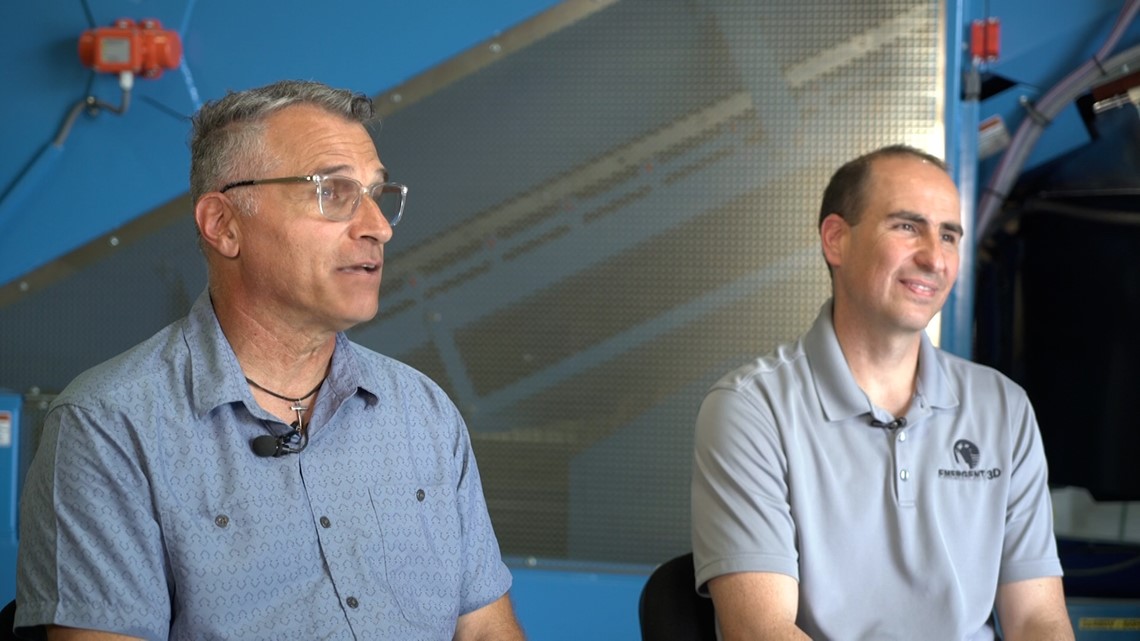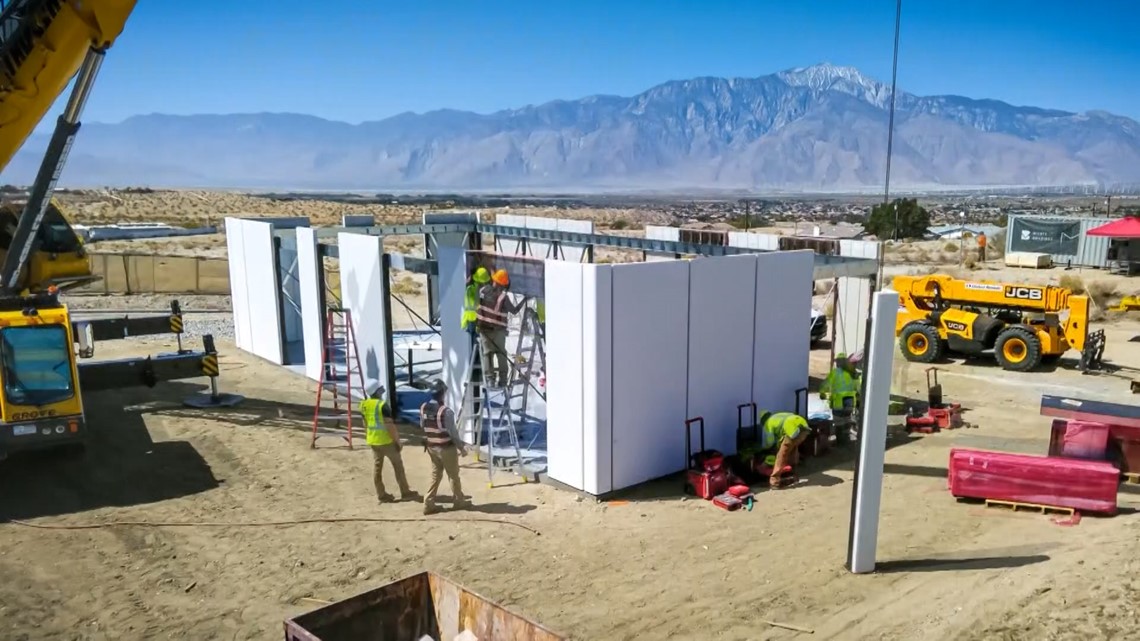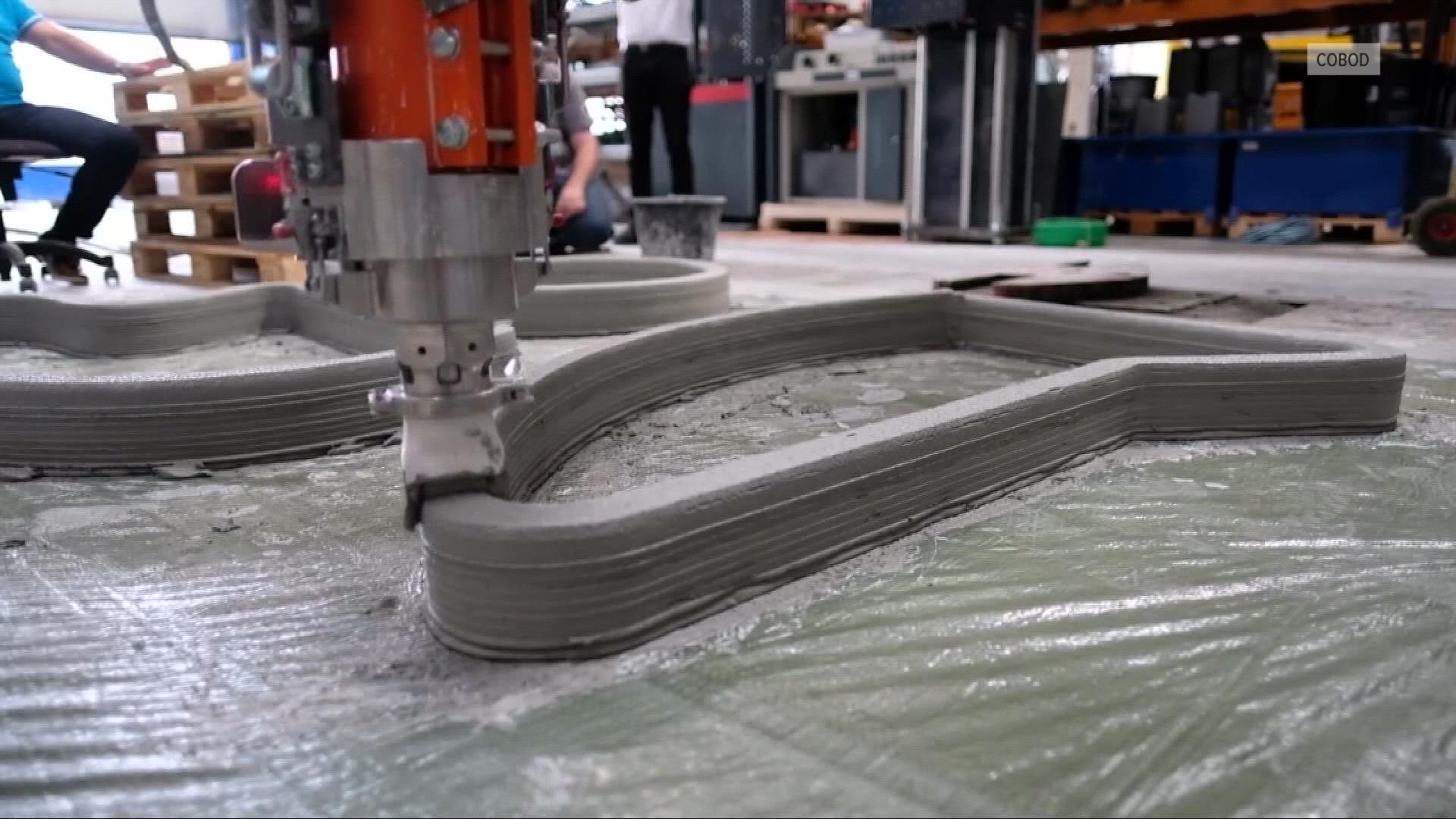CALIFORNIA, USA — California’s housing crisis involves everything from the affordability and availability of homes to homelessness, and there’s not one, simple solution.
However, two Northern California companies are trying to shake things up in the construction industry. Instead of conventional, “stick-built” homes, they are using a 3D printer, something they think will make a big difference in the future.
Emergent 3D, in Redding, and Mighty Buildings, in Oakland, have different approaches to 3D printing homes, but both say — what they’re doing can help mitigate the state’s housing crisis, especially as the technology evolves and their companies grow.
EMERGENT 3D AND WILDFIRE RECOVERY


Matthew Gile and Don Ajamian lead Emergent 3D, a Redding-based company that’s just days away from printing its first 3D home.
Ajamian, Emergent 3D’s CEO, has lived in Shasta County for more than three decades and worked as a licensed California contractor for the better part of 40 years, he said.
Gile and his family moved to Redding just two weeks before the start of the Carr Fire, which burned nearly 230,000 acres across Shasta and Trinity counties, destroying hundreds of homes and killing eight people.
Ajamian and Gile, Emergent 3D’s founder and Chief Visionary Officer, met while doing disaster recovery in the wake of the Carr Fire.
“He told me this story about 3D construction printing using concrete, and if I'm being honest, I was quite skeptical,” Ajamian said. “But Matt had persisted. He got an architect going, he got licensed California structural engineer going, and they came up with a system that — when he presented that to me, I thought, ‘Oh my gosh, there may be something here.’”
They’ll be printing what they call the “Wildfire Restoration House,” a 1,200 square-foot, three-bedroom, two-bathroom home that meets all of California’s requirements for building in wildfire-prone areas.
“The windows have to be certain types of windows, the attic ventilation can only be certain types, exterior finish, the way you treat the eaves, the type of roofing, and so on,” Ajamian explained.
“For families that are moving in, that maybe have been traumatized as a result of having to flee for their lives out of their homes and have their homes burned down, to have a concrete home…can give you some peace of mind,” Gile said.
The printing process for this 1,200-square-foot house takes less than 32 hours, but the home will still take months to finish.
“Today, if the average home is taking eight months to build just because of supply chain issues, perhaps we can get this 3D printed one done in about six months or so,” Ajamian said.
That’s because only the walls are 3D-printed. Much of the home still involves conventional construction.
“We're still putting conventional wood trusses on top. We're still putting roofing on there. There's still electrical and plumbing and cabinets and floor coverings and doors and windows,” Ajamian said. “And all those costs have even gone up over the last couple of years.”
How much does one of these homes cost?
Right now, Ajamian and Gile said, someone will save about 11% compared to a conventionally built home of the same size – and those savings can improve as the technology evolves.
“I see a day in the very near future where maybe that 11% can bump up to maybe 20%, which is significant if you think of the overall cost of a home,” Ajamian said.
The genesis of Emergent 3D, Gile said, was “to try to get our disaster recovery families rebuilt quickly and in more fire-resilient homes.”
They plan on printing their first home within the next few weeks, using an all-electric 3D construction printer from the Danish company COBOD.
As COBOD Co-Founder and General Manager Henrik Lund-Nielsen explains in a YouTube video, “You can make 3D printable concrete out of locally sourced sand, gravel, and cement, and you only need less than 1% of what we call ‘magic mix’ from us.”
“That’s the next-generation printer that COBOD created,” Ajamian explained. “They work very diligently with a company called Cemex, who is one of the world leaders in cement technology to come up with this mix design so that we can go to any jurisdiction anywhere and get their local gravel, their local sand and create a mix that will work.”
International shipping delays have pushed back Emergent 3D’s timeline, but by early September they plan to hit the ground—printing.
“What we believe is the first on-site 3D-printed house that is approved for the California Building Code, so we are primed and ready to start building,” Ajamian said.
“We really want to help address workforce housing, affordable housing, disaster recovery, and homelessness, recovery housing,” Gile explained.
Emergent 3D will be printing its first home in Redding’s Enterprise Park, where the park host and their family will be able to live on site.
Soon after, however, Emergent 3D is heading to Paradise, where the 2018 Camp Fire destroyed thousands of homes and killed 85 people.
“We'll be proactively trying to bring housing back to Paradise,” Gile said, “because of the mass devastation that happened there.”
MIGHTY BUILDINGS AND SUSTAINABLE CONSTRUCTION


Over in Oakland, a company called Mighty Buildings is focused on two crises: housing and the environment.
Mighty Buildings prints the panels of its 3D homes at its Oakland facility using a sustainably sourced, 60% recycled, resin-based material. It then assembles the pieces on-site.
Their goal is to be as sustainable as possible as they partner with developers to 3D-print entire neighborhoods.
“Our homes are modern-looking. They're bright. They're focused on energy consumption,” Chief Operating Officer Russ Atassi said. "We're looking at it in terms of, ‘How do you really fix the housing problem — the crisis that we're facing - without contributing negatively to the environment?’”
Mighty Buildings is working with developers in California now and has plans to build in other states and countries, too — addressing a housing shortage that goes beyond our state lines, Atassi said.
“We're 75% faster, end-to-end, deploying homes versus traditional home construction,” he said.
Mighty Buildings also has plans to build micro-factories near its build sites, to move the production closer to each development, create local jobs, and cut down on the cost and carbon footprint of shipping the pre-fabricated panels.
He said the cost of a Mighty Buildings home is currently about on-par with the cost of a traditionally built home of the same size. However, he said, he anticipates the cost savings from utility bills to be significant.
THE CHALLENGES FACING CONVENTIONAL BUILDERS


3D printing alone won’t solve California’s housing crisis, so we wanted to find out what’s preventing developers and construction companies from building more traditional homes to meet the demand.
For that, we turned to Christopher Brown, president of NEXT New Homes Group.
“We are ingrained in every part of the Sacramento real estate market,” he explained.
We met up with Brown in Roseville, where his company is building 11 higher-end homes as part of a larger development.
“You know, we went through an exorbitant increase in demand during COVID. Unprecedented,” he said. “We as homebuilders normally go, ‘Oh, great. We're going to build more homes this year.’ Well, we didn't have materials and we didn't have any labor.”
He said the price of lumber alone is 60% higher than the 25-year average.
“That goes into the price of the house,” he said.
In May, the National Association of Homebuilders’ Chief Economist said building material costs were up 19% from a year prior.
“We've got plywood, we've got lumber, we've got steel, we've got drywall,” Brown listed off, looking around a house under construction.
Plus, he said, the permitting process can take years, and local fees drive up costs, too. The North State Building Industry Association estimates an average of about $95,000 in fees per house in the Sacramento region — and $55,000 throughout other parts of the Central Valley, all of which gets passed along to the homebuyer, Brown said.
“Every time we raise prices and we're building a home for $500,000…people have to understand…what went into that is probably about $490,000 worth of cost and there's that little bit left over,” Brown said. “If you understand that, you know, that helps to understand, ‘How do we fix things in California?’”
REGULATING AND INSPECTING 3D PRINTED HOMES
Could 3D printing make a difference in the conventional homebuilding industry?
“Even though everything we do is very risky, because of the market ups and downs,” Brown explained, “we're a very risk-averse business, partly because we know how to build things. And we know what works.”
Still, he said, “we would love to bring more new things like 3D printing and those kinds of things. But if we brought that to a community here in Sacramento, we now have to educate all the building officials, all the planning officials, because it's different.”
That’s something Mighty Buildings and Emergent 3D know all too well.
“We're working with jurisdictions…and regulatory agencies…There's definitely an educational process because these are different than your stick build operation," Atassi said.
Emergent 3D is excited to have approvals from four local governments for its Wildfire Restoration House.
“After the city of Redding, we got it approved in Shasta County, in Butte County, and in the town of Paradise," Ajamian said.
COULD THIS JEOPARDIZE CONSTRUCTION WORKERS' JOBS?
ABC10 asked both companies whether using a machine to do what people have always done - build the walls of a home - could put some people's jobs at risk.
“There's a limited number of construction workers out there and there's a limited amount of money...to solve our housing crisis," Ajamian replied. "If we can reduce the cost of building a home and reduce the number of man-hours…we can leverage those limited resources to actually build more homes, and that's the ultimate goal.”
Over at Mighty Buildings, Atassi pointed to the company's plans to build temporary micro-factories near their developments, "so these micro-factories are enabling us to really also create the jobs in certain regions as we deploy, which makes it - again - a win-win strategy for everybody."
However, ABC10 also reached out to the UC Berkeley Labor Center, to run these questions past the researchers there.
Enrique Lopezlira is Director of the Labor Center's Low Wage Work Program. He said while "it’s probably too early to tell with this technology," he added that "when technologies come on the market, they might replace tasks but not necessarily jobs."
He pointed out that, currently, 3D construction printing is not widespread or cost-effective enough to make a significant impact on the housing industry, but if it grows and more studies are conducted, the technology could make a bigger difference in the future. As of now, 3D printed homes still require electricians, plumbers, roofers, and others within the conventional homebuilding space.
“All new technologies have the potential to improve productivity, but they also have the potential to make things less productive, based on how it’s ultimately employed," he said.
3D construction printing also requires workers to have more technical knowledge, he said, which could lead to better-paying jobs, as people will have to learn the equipment.
He also mentioned that "jobs are not finite. Sometimes we tend to think of job creation as a zero-sum game." If some jobs are eliminated by a technology that ultimately boosts productivity and improves the income of a nation, then other, new jobs can be created.
“You do want jobs that go away to be replaced by jobs of good quality and good pay," Lopezlira said. "But that’s a policy thing more than a tech thing."
FOLLOW To The Point:
► Follow Alex on Facebook and Instagram
► See all of To The Point stories
► Watch To The Point with Alex Bell every weekday night from 6:30 - 7 p.m.
PRINTING INTO THE FUTURE
Emergent 3D plans on printing their homes to help more than just wildfire survivors.
“We really want to help address workforce housing, affordable housing, disaster recovery, and homelessness-recovery housing," Gile said.
And Mighty Buildings plans on printing entire sustainable neighborhoods with hundreds of homes each.
“I think we're just scratching the surface where this can go," Atassi said.
Both companies are adding to the housing stock and chipping away at the housing crisis one layer at a time.



















